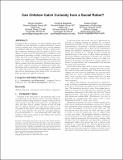Can Children Catch Curiosity from a Social Robot?
Author(s)
Gordon, Goren; Breazeal, Cynthia Lynn; Engel, Susan
DownloadBreazeal_Can children catch.pdf (135.6Kb)
OPEN_ACCESS_POLICY
Open Access Policy
Creative Commons Attribution-Noncommercial-Share Alike
Terms of use
Metadata
Show full item recordAbstract
Curiosity is key to learning, yet school children show wide variability in their eagerness to acquire information. Recent research suggests that other people have a strong influence on children's exploratory behavior. Would a curious robot elicit children's exploration and the desire to find out new things? In order to answer this question we designed a novel experimental paradigm in which a child plays an education tablet app with an autonomous social robot, which is portrayed as a younger peer. We manipulated the robot's behavior to be either curiosity-driven or not and measured the child's curiosity after the interaction. We show that some of the child's curiosity measures are significantly higher after interacting with a curious robot, compared to a non-curious one, while others do not. These results suggest that interacting with an autonomous social curious robot can selectively guide and promote children's curiosity.
Date issued
2015-03Department
Massachusetts Institute of Technology. Media Laboratory; Program in Media Arts and Sciences (Massachusetts Institute of Technology)Journal
Proceedings of the Tenth Annual ACM/IEEE International Conference on Human-Robot Interaction - HRI '15
Publisher
Association for Computing Machinery (ACM)
Citation
Gordon, Goren, Cynthia Breazeal, and Susan Engel. “Can Children Catch Curiosity from a Social Robot?” Proceedings of the Tenth Annual ACM/IEEE International Conference on Human-Robot Interaction - HRI ’15, March 2-5, 2015, Portland, Oregon, USA. pp. 91-98.
Version: Author's final manuscript
ISBN
9781450328838